I ate my first mushroom from the Amanita amerirubescens group this year, but it wasn't the first time I'd met them, or collected them. As many of you know, the often-avoided genus has a number of lethally poisonous mushrooms, as well as some very well known edibles in it.
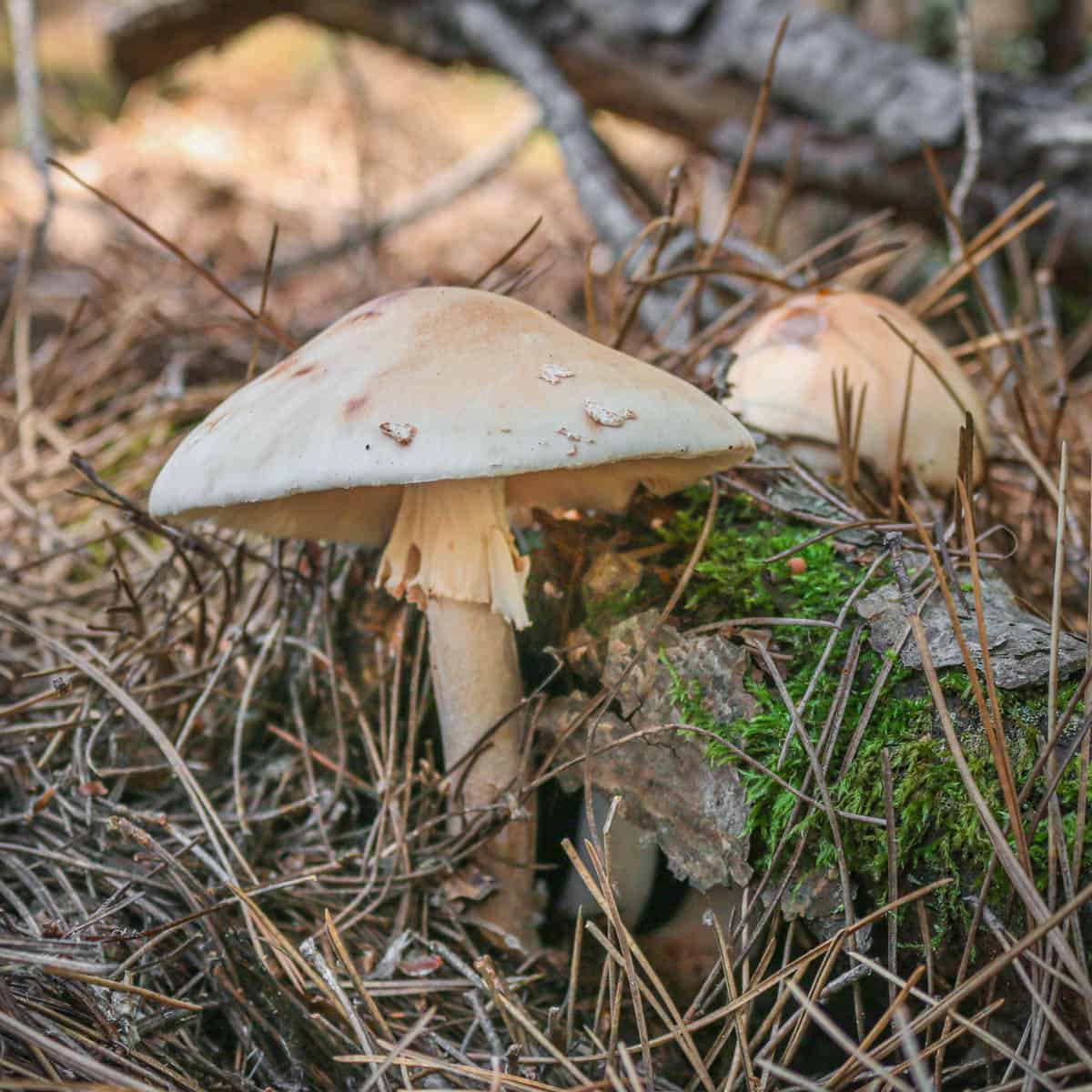
I first found them first 3 years ago, after picking blueberries in the pine barrens. Walking around looking for wintergreen leaves, I found a number mushrooms I suspected were in the amerirubescens group growing in a plantation of mature red pines. I brought them home, inspected them, and discarded them after a day or so. The next year I found them again, in the same spot, and repeated the process of bringing them home, inspecting them, and discarding.
Here and there I see people get scolded for picking mushrooms they don't know, but as far as I'm concerned, harvesting mushrooms is an important part of the learning process. Don't get me wrong, I play the point-and-name game plenty, especially if I'm with someone new, but if I'm trying to learn a new edible, I do my homework. In my mind:
It's nothing to harvest mushrooms you don't know for the purposes of identifying them, bring them home, and discard them, multiple times, until you could shout to a group of mycologists exactly why you know the species you have is what you think it is. With an amanita, your life could literally depend on it.
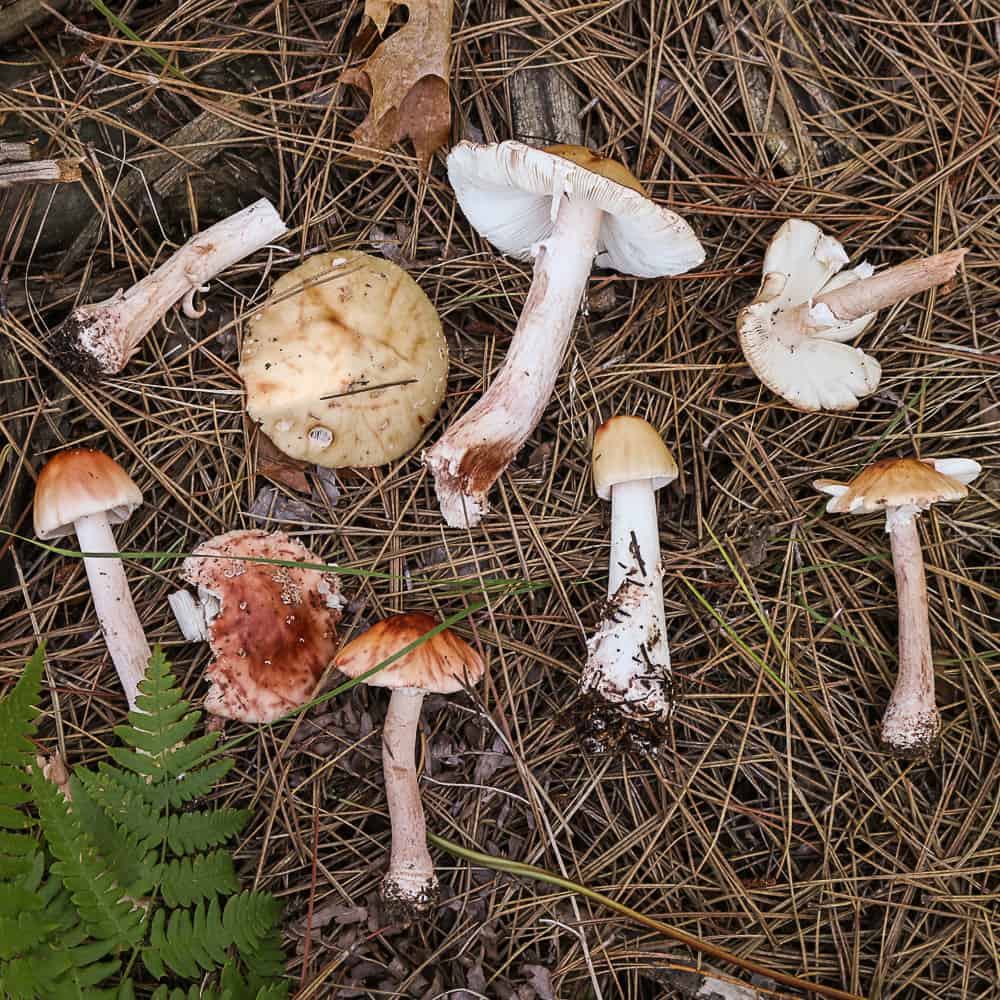
There's all kinds of things to notice: does it stain when touched, if so, how fast after handling, 1 minute, 30 minutes, 2 hours? Are they firm and robust, heavy as a paper weight, or thin and fragile, falling apart with too gentle handling? What color are the spores? What do they smell like today, then, what do they smell like tomorrow after sitting on the counter? What's the texture of the cap like? Is it tacky? Dry? Velvety? Slimy? Gelatinous?
Blushers have a few characteristics that stick out, so while I'm not going to recommend anyone eat them, at least in Minnesota or Wisconsin where I've seen them I hope a few images and description of what made me sure enough of my ID to eat them can be helpful.
I spent extra time digitally correcting the color with a histogram, too. For the most correct color, see the mushrooms photographed on slate at the bottom of the post, as the light was a little warm and direct in the field. Also keep in mind that these are only one collection from Minnesota, and they're part of a group of mushrooms containing other similar, but unique ones, and, the last time I checked, some that are unnamed.
My Blusher ID List
This isn't a comprehensive list, but it's what helped me feel comfortable enough to eat them after 3 rounds of collecting.
Blushing
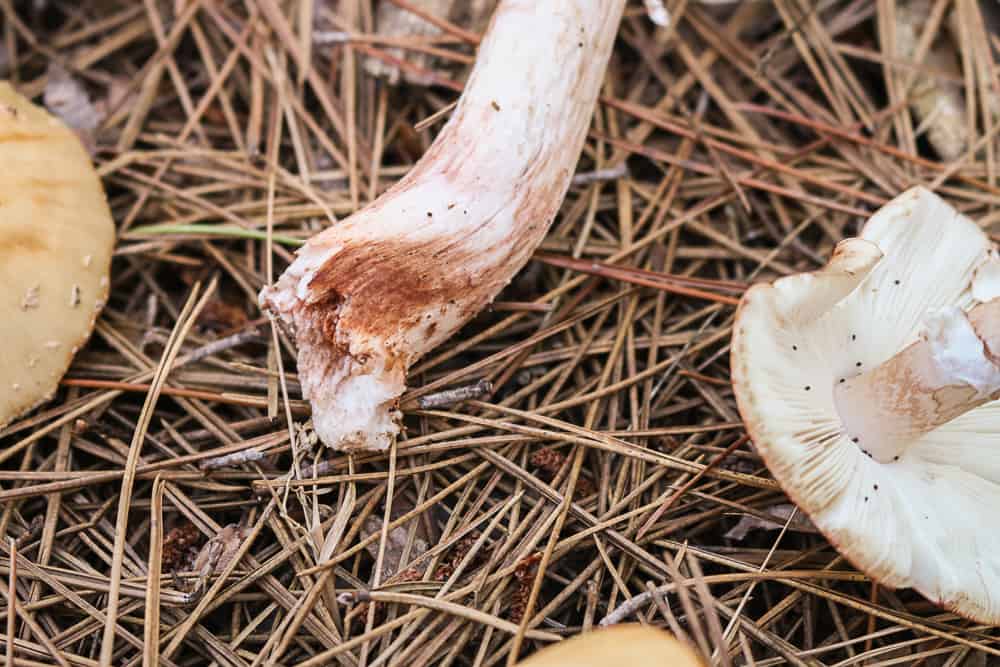
They all bruise red-ish. True blushers *all* blush, and I made sure every single one I put in my basket I touched to confirm that, since other amanitas can grow in the area. If it doesn't blush red-ish pink, it could be an imposter, like a panther Amanita, or something else (Arora describes an unnamed look-alike that bruises brown).
Bug damage and tunneling bruises red
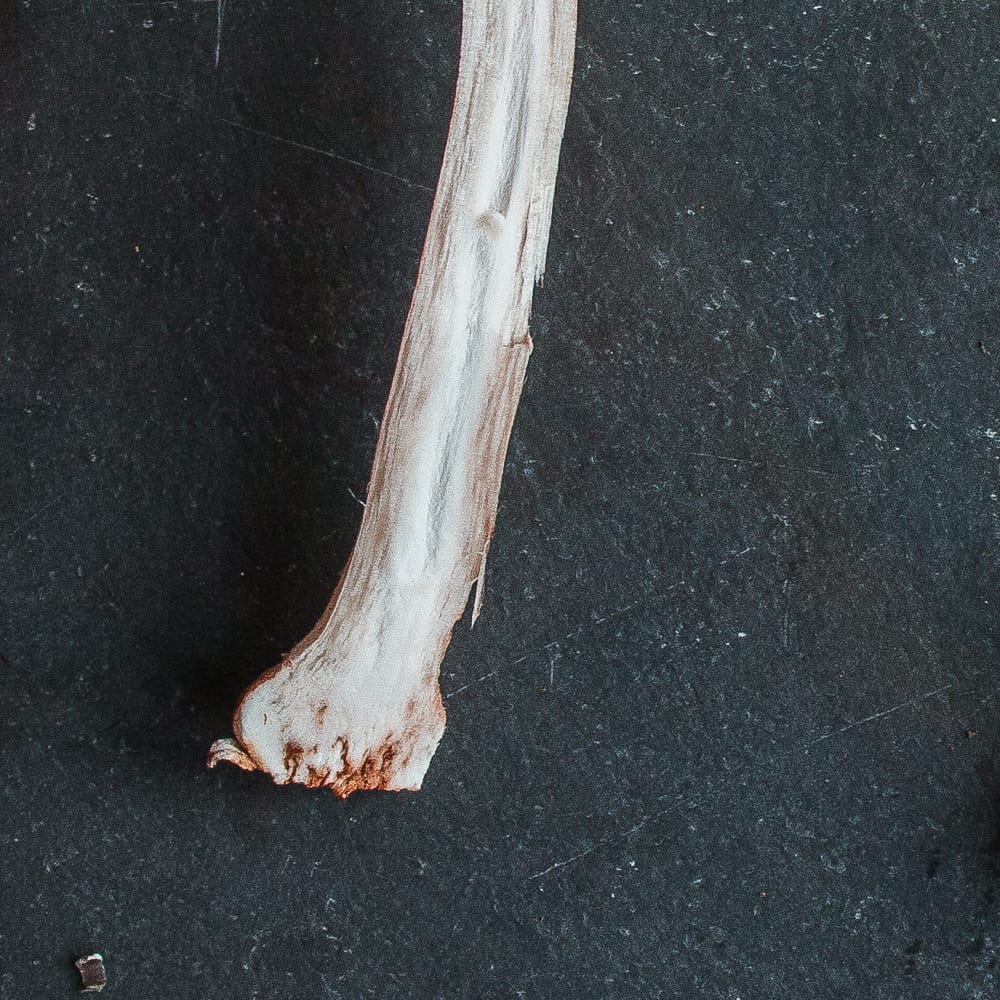
No Sac
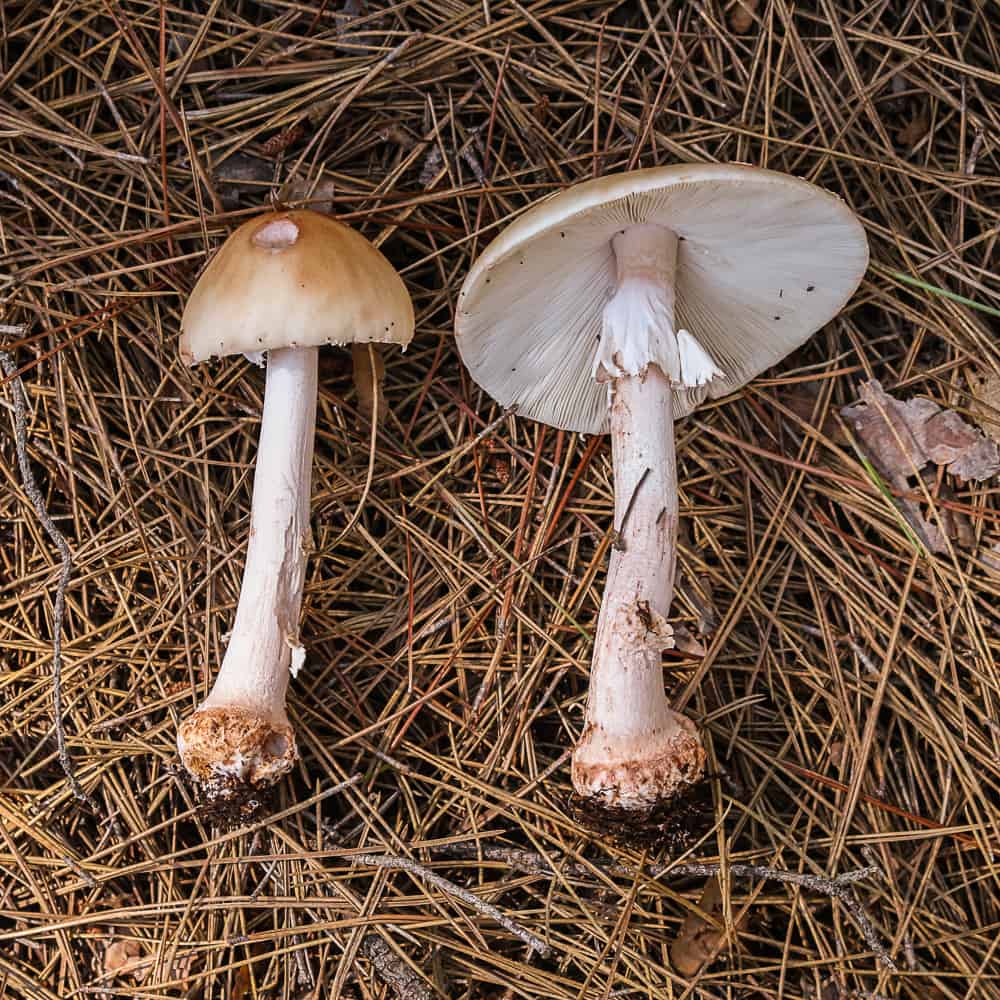
No sac at the base of the stem like dangerous Amanitas (Ocreata, Phalloides, and similar) rather, the base looks a little bulbous (indistinct) I think it kind of resembles the end of a cane with a rounded end.
Warts on the cap
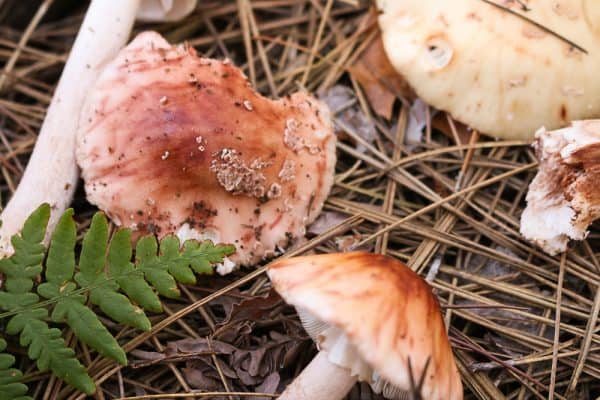
Tasting notes
So, how do they taste? A delicacy like the ones from France are rumored to be? At least for me and this collection, no, not in the least. While I'm at it, here's something I find helpful re: tastes of new mushrooms. If you hunt mushrooms you'll probably agree with me that chanterelles taste good, really good, and they score high on all the counts I can think of: wide availability, dependability, long shelf life, relative ease of Identification, and taste. So, when I taste a new mushroom, or I'm comparing other mushrooms to weigh their value, I like to ask myself: "How's this compared to a chant?".
My Amanita amerirubescens were, not that great. Not good enough to hold a chants jewelry in my opinion. I cooked them down with the wet saute method, putting a finger of water in the pan and cooking it dry before I added fat to ensure they were fully cooked, since blushers need thorough cooking.
I found them bland and not too interesting, especially since I could've thrown a rock where I was, at the time I was there, and picked another basket full of Newfoundland chants (Cantharellus enelensis). It was the least interesting of the 5-6 amanitas I've eaten, the two best which were A. velosa, and A. muscaria, respectively. Here's the exact entry from my tasting notes as I ate them:
"They reminded me of grisettes in that they were brittle and a pain to bring out of the woods and keep separate, since the chanterelles would've battered them around. The texture of the stem was soft on the youngest, most firm one I ate, enough so that I needed a very sharp knife to cut it. The flavor was much milder than I expected, a touch nutty, but nothing crazy, just mild and mushroomy. Very mild. I prefer the taste of fried Amanita muscaria, and that's after boiling. They taste fine fried in butter, but what doesn't? I don’t know if I would go out of my way to collect them, maybe if I saw a large flush they could be very nice simmered in Asian style broth or pho, maybe."
If you've eaten these, especially if you've liked a version from where you live, wherever that may be, drop a comment below. I assume the French species is better (the pictures look more robust and larger, for one) but, since David Arora also gave them a luke-warm taste review in Mushrooms demystified, I'm skeptical.
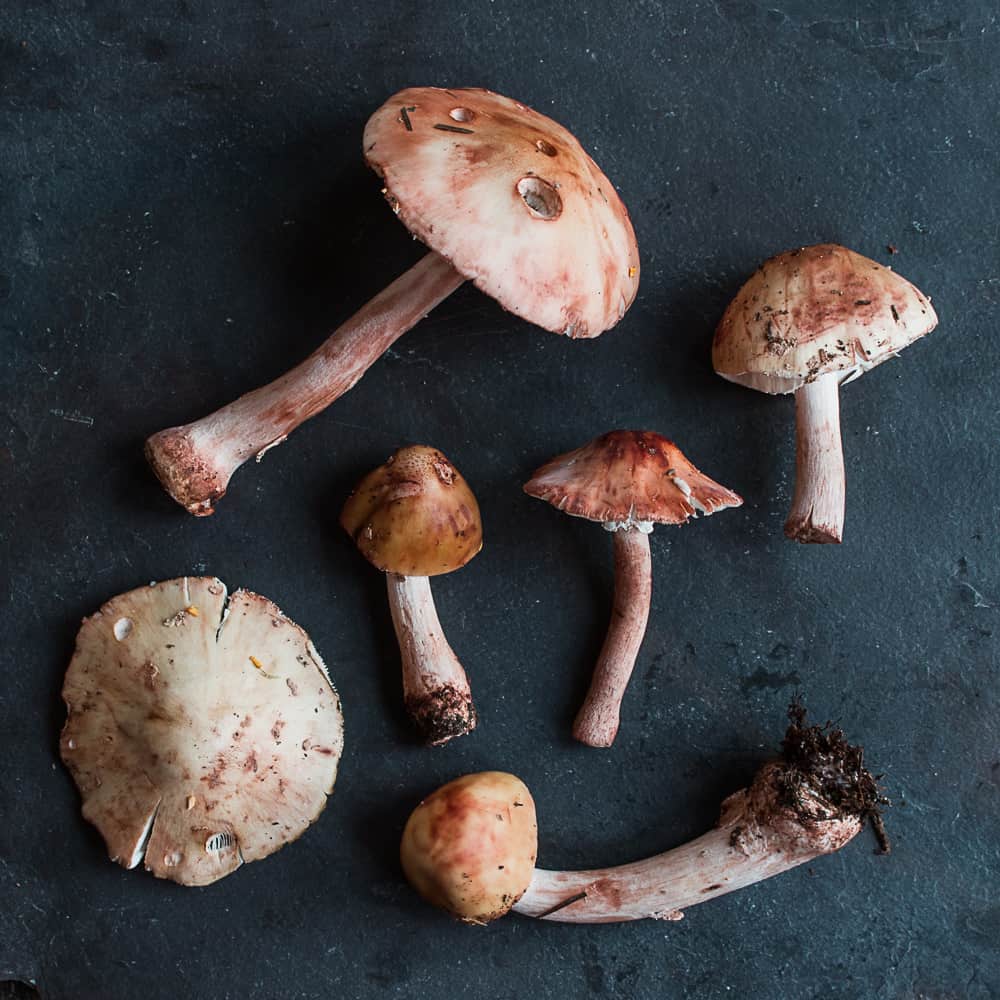
Further reading
The first link below was a useful grouping and description of different North American A. amerirubescens-type mushrooms, some of them unnamed yet. David Arora's account in Mushrooms demystified, like with so many others, was very helpful too.

Jay
Hi, i cooked these for the first time yesterday. I never boiled them 1st, i never knew i was supposed to to be honest. What i thought i would do is semi dry them to remove the water content and intensify the taste so i could really isolate the flavour of this particular mushroom. So i put them whole on a rack and put them in oven at about 180c and turned them every 20mins, a lot of water was coming out of them and they was shrinking well. i put some water in the bottom of the grill pan to stop the juices burning. After about hour they had shrunk a lot and had a much firmer texture to them. Upon tasting them, with not even salt, i was pleasantly surprised I have to say. They was very tasty indeed, reminded me of lobster or prawns. I also used same technique with charcoal burners which it also worked well with. I'm not sure now if not boiling them 1st was a bad idea, or cooking them for long and high temp has had same effect. But the flavour was excellent. What do you think? I mean boiling them would sure remove a lot of flavour and maybe why people don't rate them, but is it safe?
Alan Bergo
Hi Jay, you don't have to boil them, just cook them thoroughly.
Enrico
Hi, picked quite a few of these today. Done so a couple of times before but, despite being 99.9% of the ID, I just couldn’t and they went in the bin.
This time I really wanted to try and for this reason took home a fair few good specimens but… I have now read on a few places that you have to peel the caps before cooking?!? Is that necessary or would a long hot cook work just as well? If the former, based on most people saying they aren’t all that good, they are headed for the bin and off my list forever.
Thanks!
Alan Bergo
Hello. There’s no need to peel the caps. Just make sure to cook them thoroughly.
Kathleen Rodgers
I find the blushers here all of the time. I rarely find them unbuggy! The red is really pronounced!No, I have not eaten any amanita. I like my kidneys and liver a whole lot. They are however very attractive
!
Alan Bergo
Thanks for sharing Kathleen. Some Amanitas are quite good. Last year I ate a few pounds of Amanita jacksonii.
Karen Callis
Good to know! I just found a few yesterday. You are our "go to guy" on You Tube for culinary mushrooms. 😁
Alan Bergo
Hey thanks Karen.
david
I like 'em- - I'm in Yorkshire UK & they're plentiful, I think because no one else picks them..
Current fave recipe from here...
https://www.gone71.com/blusher-amanita-rubescens/
Alan Bergo
Yes as you might infer from the epithet amerirubescens, my local species could be be different in the kitchen from yours. I wish I liked mine more. I should give them another shot.
Joe
At first I thought they were panther caps which I've never tried to eat.
I'll try the bruising method of identification and check the spore print. I'm not sure what the spore print should look like.
There's not an over abundance of them here and they're not that heavy and you say they don't taste that great so I'll probably throw them in the woods near the driveway just for conversation or woods decoration.
Alan Bergo
They're ok but they aren't incredible. I tried a few more this year.
John Dobson
Hi Alan
I collect and eat Amanita Rubescens from the commercial spruce forests in North East England. The specimens I find are certainly sturdier than those in your photos and I don't bother with pre-boiling, since the toxins aren't water-soluble. I find them really tasty and they can save the day when the ceps haven't popped up as they are very common and few people seem to bother with them.
Melanie
I found what i believe is an amanita amerirubescens , however lining the inside of the cap is a pale yellow skin . does that sound right ??
Alan Bergo
Post your pics in a mushroom group, or send them to my email (preferably you will do both). alanbergo3 AT gmail.com
Sam
In my experience the white blusher is very mild and pretty ordinary with a bit less of the mushroomy flavor then typical. But, the regular blusher I found to have a slight white fish flavor that I have specially noticed when I microwave a piece or I suppose you could steam it.
Alan Bergo
Thanks Sam.
Jacqui
Hi Alan and other folks,
I found my first blushers (Amanita rubescens - I am in France) that were in good shape today (I found some that had been trodden upon on Saturday). And they were unambiguously and clearly blushers. I peeled the caps AND pre-blanched them and tossed the water before dry frying to brown and dry them before I added a bit of salt and butter. And they were ... fine but not astonishing. Of course the pre-blanching did not improve the texture.
But the grey knight (Tricholoma terreum) that I had just dry fried (they are small) and buttered were really nicer, as were the blewits. I'll leave the Amanita for other people in future.
Alan Bergo
Jacqui, thanks for chiming in. I'm jealous you still have weather that allows you to get outside. I agree re: Tricholoma vs A. rubescens. I would much prefer T. equestre to the latter, although with those I of course wouldn't eat too many.
Jacqui
I need to update this comment. I picked up a couple of young blushers that somebody else had knocked over, and rather than leave them for the slugs I brought them home, peeled the caps and fried them, first with a bit of water then added some butter when the pan was dry, making sure that everybody was well-cooked, as I had seen on a video of a french chef-type-person preparing them in a sauté pan just by sweating and frying them. And they were really excellent. My first ones (one comment up) had definitely suffered from the 15 minutes in boiling water. So I have to reassess them to slide them higher on the list of desirable mushrooms. Indeed, black trumpets and chants are still a bit higher, but ... not that much.
Flanman
Hey Alan - thanks for this post on something somewhat controversial! Amanitas can and should be something to REALLY know and understand, A good friend of mine said the Caesar Amanita was one of the best mushrooms he ever ate, but again you need to know what you are doing in the mushroom world and then with Amanita its really a cut above. I pick mushrooms all the time and belonged to a club for many years but picking Amanita just isn’t in my future. To your point, there’s too many other great mushrooms to love. That are soooo much less complex like Hericium, Oyster, Hen, Chicken, King, Trumpet- need I go on.
I just picked 15 cups of the Autumn Olive Berry - made some low sugar jam out of them - my first experience with them. Would love to see a post from you on those invasive species. I’m hoping it goes well with cedar planked salmon and venison heart at breakfast,
GREAT work on the videos this year! Thanks man
.
Alan Bergo
Thanks David. I haven't found Autumn Olive where I live yet, but I think there should be some east a ways in Wisconsin.
Randall Thompson
Thanks, Great info, but I'll leave these alone
Alan Bergo
Yes. Not saying everyone should strive to eat Amanitas here, just sharing the process and methodology I go through when studying And judging new species for their table value.
Louise
I value your notes. Like when I found Shingled Hedgehogs and read differing ideas about their edibility. I won't pick them again, nor will I try any amanita on my own. I did eat one raw in Italy and wow it was great.
I joked to the friend I was foraying with that in war time, many a fungi was picked to help a family survive. That doesn't mean the mushroom was delicious. I suspect any edible mushroom would taste good cooked in enough butter.
Maddy Papermaster
Can’t tell you how much I appreciate your posts.
You are truly gifted and thanks for sharing.
Brighten my day!
Maddy Papermaster ma
Betsy
Fascinating to read all the things you observe in these. Plus, bonus points for the observation, “They taste fine fried in butter, but what doesn’t?” Truer words were never spoken!
Ed
Good morning, your meticulous details are wonderful! Is there a field guide available that you trust the most?
Thanks, Ed
Alan Bergo
Hey Ed, Yes, David Arora Mushrooms Demystified, and his smaller book all the rain promises and more, along with Michael Kuo: 100 edible wild mushrooms are great places to start, but, as there's still a lot out there we don't know, and things are changing every year, especially with binomials and re-classification, Facebook groups for local regions (however I feel about FB aside) are an extremely efficient way to directly contact mushroom experts in your region, or specialists across the country that work closely with a specific Genus. Notable groups are False Morels Demystified, Boletes of North America, and your basic Wild Mushroom ID groups.